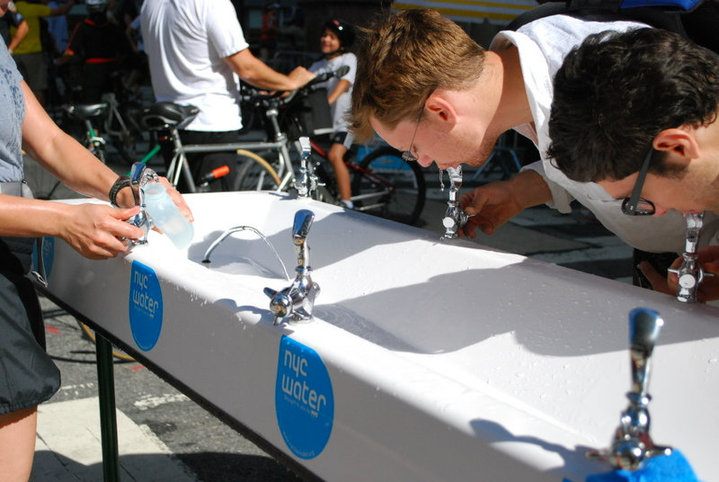
Many decades ago, New York City had a reputation for being a relatively unclean place. From subways to the streets, loads of garbage and graffiti were quite pervasive. Today, NYC is still technically ranked among the dirtiest cities in the country, but millions of tourists go there each year to see the sights, sounds, and be entertained in a variety of ways. Despite how gritty some areas still look, there’s one thing that’s surprisingly clean and refreshing about The Big Apple: its tap water. Seriously, taste it the next time you’re in the area and you may get jealous that the water in your own city doesn’t taste as good.
Here are ten surprising facts about New York City tap water:
1. NYC’s water costs about one penny per gallon. This isn’t the lowest priced tap water in the country, but the cost of New York City tap water is below that of many other major cities. In fact, NYC utility bills for water are some of the most reasonable in the Northeastern US.
2. The NYC system provides approximately one billion gallons of water to its 8.5 million residents each day. This may seem like a lot, but consider the fact that the New York City tap water supply goes to all of the people living within the city as well as one million others living in Putnam, Orange, Ulster, and Westchester counties.
3. The Department of Environmental Protection conducts over 500,000 quality tests on New York City tap water each year. This not only ensures that the water tastes good, it also helps keep the water supply safe for all of the area’s residents. The amount of testing that NYC performs on its water supply is more than average when compared to other major cities.
4. NYC water comes from a complex system of reservoirs and different watersheds. The watershed is located in the Southeastern part of the state and consists of the Croton, Delaware, and Catskill watersheds in addition to 19 different reservoirs. The water flows from a network of aqueducts and tunnels, is treated, and is then sent to taps for the people of NYC to use.
5. According to NYC’s pizza parlors, local tap water is key to what makes their crust’s flavor different from any other in the world. This is apparently why the pizza in New York City is notoriously difficult to replicate outside of the city. If you’re sitting at home wondering why your homemade, takeout, or store bought pie’s crust is nothing like the foldable slice you had in a NYC pizza joint, now you know.
6. Chlorine is used to disinfect New York City tap water. The main reason the chemical is used is to keep pathenogens and harmful microorganisms that cause diseases — such as dysentery, cholera, typhoid, and GI problems — out of the water supply. New York’s neighbor, New Jersey, was the first state to add chlorine to a public water supply in 1908.
There’s been some controversy over the years about the city’s choice to chlorinate its tap water, but it’s a time tested method that works. Campers, people in countries with low quality water, folks caught in power outages, and homeowners with wells have been adding household chlorinated bleach to their water for years with little ill effect.
7. Most of the water that feeds the NYC system comes from rain and snow. Reliance on precipitation is a large part of why the system that generates the city’s tap water is irreplaceable. NYC’s Watershed Program constantly monitors the area’s water in an attempt to maintain a steady and stable supply. The city is also implementing initiatives through its Water Demand Management Plan to conserve the precious resource, such as providing residents with high efficiency toilets, helping commercial entities better manage their water usage, and optimizing the distribution of the city’s water.
8. All New York City tap water contains copepods, a type of shrimp that is invisible to the naked eye. Yes, it’s a bit creepy, but the little guys serve a purpose. And, thankfully, not having to see them means most people drink the city’s tap water without ever realizing their presence. The copepods are beneficial because they keep mosquito eggs and larvae out of the water, making it safer. Having tap water filled with teeny shrimp means it isn’t vegan or kosher, but without them what NYC residents get from their taps wouldn’t taste nearly as good. FYI, many other cities throughout the country also have copepods in the water supply, including Boston and San Francisco.
9. Since 1993, over $1.7 billion has been invested by the city to protect its watershed. Conservation measures are a smart move, especially considering that the water used for the city’s system is irreplaceable. Protecting its water supply is part of an effort to get NYC as green as possible. Along with investing in the watershed, city leaders are working to make public transportation, businesses, government institutions, and schools more eco-friendly and sustainable. Improving air quality is also a concern in NYC.
10. New York City tap water won a 2016 Regional Taste Test Competition. Some have called the water that flows from taps in NYC the creme de la creme and champagne of city tap water. Apparently, it really is that great because New York City tap water has been winning city, state, and regional taste tests for years. This must be why those dining at restaurants in the city often ask for tap water instead of bottled.
Superstar rapper Jay Z, who is a New York City area native and resident, famously said, “You should drink free water from the tap — it’s a beautiful thing.” If you’re living in NYC or visiting and have access to the awesome tap water there, it is indeed a beautiful thing.
References
http://www.nyc.gov/html/dep/html/press_releases/16-077pr.shtml#.V8xB3jXAYrd
http://gizmodo.com/5626497/you-swallow-invisible-shrimp-with-every-gulp-of-nyc-tap-water?utm_source=feedburner&utm_medium=feed&utm_campaign=Feed%3A+gizmodo%2Ffull+%28Gizmodo%29
http://www.dec.ny.gov/lands/58524.html
http://www.cleaningservicenewyorkcity.com/fun-facts-about-new-york-city.html
http://www.cdc.gov/healthywater/drinking/public/chlorine-disinfection.html


Comments
Loading…